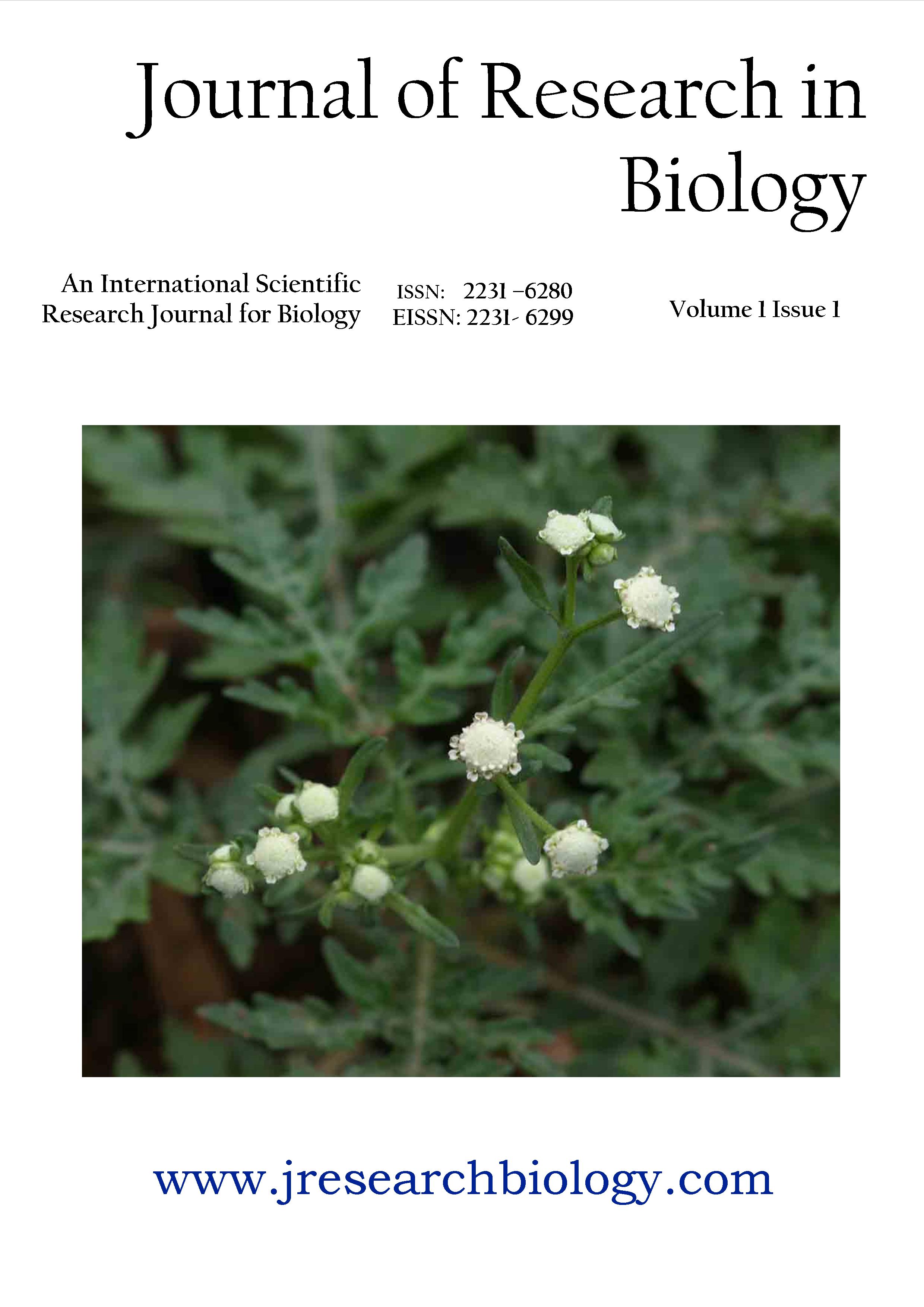Abstract
This study evaluated the antimicrobial potency of aqueous extract of three common medicinal herbs, Azadirachta indica (Neem leaves), Solanum torvum (Sundakai fruit coat) and Curcuma longa (Turmeric,rhizome) against the in vitro growth of pathogenic bacterium Aeromonas hydrophila isolated from infected fresh-water fish, Channa striatus was assessed by disc diffusion assay.
Determination of minimum inhibitory concentration (MIC) for each aqueous herbal extract was done on Muller Hinton agar swabbed with 0.5 ml of overnight culture of A. hydrophila (106cfu/ml). After incubation period, zones of inhibition around herbal extracts incorporated discs were measured.
The strongest antibacterial activities among all plant species were obtained by the aqueous extract of A. indica with inhibition zone of 18 mm against A. hydrophila. S. torvum demonstrated moderate (11 mm) and C. longa marked weak (8 mm) inhibiting activity against A. hydrophila.
References
Abutbul S, Golan-Goldhirsh A, Barazani O, Ofir R and Zilberg D. 2005. Screening of desert plants for use against bacterial pathogens in fish. Isr. J. Aquacult.- Bamid., 57(2):71-80.
Alcaide E, Blasco MD and Esteve C. 2005. Occurrence of drug-resistant bacteria in two European eel farms. Appl. Environ. Microbiol., 71:3348–3350.
Amal G, Al-Bakri and Fatma U. Afifi (2007). Evaluation of antimicrobial activity of selected plant extracts by rapid XTT colorimetry and bacterial enumeration. Journal of Microbiological Methods,Volume 68, Issue 1, January 2007, Pages 19-25.
Bansemir A, Blume M, Schröder S and Lindequist U. 2006. Screening of cultivated seaweeds for antibacterial activity against fish pathogenic bacteria. Aquaculture, 252:79–84.
Cabello FC. 2006. Heavy use of prophylactic antibiotics in aquaculture: A growing problem for human and animal health and for the environment. Environ. Microbiol., 8(7):1137-1144.
Dhayanithi NB, Ajith Kumar TT and Kathiresan K. Effect of neem extract against the bacteria isolated from marine fish Journal of Environmental Biology July 2010, 31, 409-412 (2010).
Direkbusarakom S. 2004. Application of medicinal herbs to aquaculture in Asia. Walailak Journal of Science and Technology, 1(1):7–14.
Prescott LM, Harley JP and Klein DA. 1990. Microbiology, Wm. C. Brown Publishers, Dubuque, IA, USA.
Punitha SMJ, Babu MM, Sivaram V, Shankar VS, Dhas SA, Mahesh TC, Immanuel G. and Citarasu T. 2008. Immunostimulating influence of herbal biomedicines on nonspecific immunity in Grouper Epinephelus tauvina juvenile against Vibrio harveyi infection. Aquacult. Int., 16:511–523.
Rios JL and Recio MC. 2005. Medicinal plants and antimicrobial activity. J. Ethnopharmacol., 100:80- 84.
Roberts RJ, Frerichs GN, Miller SD. Epizootic ulcerative syndrome, the current position. In: Diseases in Asian Aquaculture. I. Fish Health Section. Edited by Shariff M., Subasinghe R.P., and Arthur J.R., Asian Fisheries Society, Manila, 1992, pp. 431-436.
Seyyednejad M, Ebrahimzadeh H and Talaie A. 2001. Carbohydrate content in olive zard c.v. and alternate bearing pattern.J.int.sugar,103(1226):84-87.
Sivapriya M, Dinesha R, Harsha R, Gowda SST and Srinivas L. Antibacterial activity of different extracts of Sundakai (Solanum torvum) fruit coat,International Journal of Biological Chemistry 5 (1):65-67, 2010.
Sørum H and L’Abée-Lund TM. 2002. Antibiotic resistance in food-related bacteria – a result of interfering with the global web of bacterial genetics. Int. J. Food. Microbiol., 78:43–56.
Van Der Nat MG, Van Der Sluis KTD and Labadie RP. 1991. Ethnophormo-cognostical survey of A. indica Juss (Maliaceae). J Ethnopharmacol., 35:1– 24.
Vishwanath TS, Mohan CV, Shankar KM. Mycotic granulomatosis and seasonality are the consistent features of epizootic ulcerative syndrome (EUS) in fresh and brackishwater fish of Karnataka, India. Asian Fish Sci 1997, 10, 149-154.
Wafaa A, Helmy, Hassan Amer MA, Nefisa and EL-Shayeb. Biological and anti-microbial activities of aqueous extracts from neem tree (Azadirachta indica A. Juss., Meliaceae). J.App. Sci. Res., 3, 1050-1055 (2007).
Dubber D and Harder T. 2008. Extracts of Ceramium rubrum, Mastocarpus stellatus and Laminaria digitata inhibit growth of marine and fish pathogenic bacteria at ecologically realistic concentrations. Aquaculture, 274:196–200.
Harikrishnan R, Nisha Rani M and Balasundaram C. 2003. Hematological and biochemical parameters in common carp, Cyprinus carpio, following herbal treatment for Aeromonas hydrophila infection. Aquaculture, vol. 221, no. 1-4, p. 41-50.
Hobbs C. Echinacea: A literature review. Special Supplementt to HerbalGram 1994, 30, 33-48.
Jin LZ, HO YM and Jalaludin S. 1996. Antagonistic effects of intestinal Lactobacillus isolates on pathogens of chicken. Lett. in Appl. Microbiol. 23, 63 – 71.
Junaid SA AO Olabode, FC Onwuliri, AEJ Okwori, SE Agina. (2006) The antimicrobial properties of Ocimum gratissimum extracts on some selected bacterial gastrointestinal isolates.African Journal of Biotechnology. Vol 5, No 22 ISSN: 1684-5315.
Lenette EH, Balows A, Jr. Hausler WA and Shadomy H.J. Manual of clinical microbiology (Eds.) 4th Edn. American Society for Microbiology, Washington (1985).
Lilley JH, Phillips MJ and Tonguthai K. 1997. A review of epizootic ulcerative syndrome (EUS) in Asia. Aquatic Animal Health Research Institute and Network of Aquaculture Centres in Asia-Pacific, Bangkok.
Muniruzzaman M and Chowdhury MBR. 2004. Sensitivity of fish pathogenic bacteria to various medicinal herbs. Bangladesh Journal of Veterinary Medicine, 2 (1):75-82.
Naylor R and Burke M. 2005. Aquaculture and ocean resources: raising tigers of the sea. Annual Review of Environmental Resources, 30:185–218.
Copyright license for the research articles published in Journal of Research in Biology are as per the license given below
Creative Commons License
Journal of Research in Ecology is licensed under a Creative Commons Attribution 4.0 International (CC BY 4.0). (www.creativecommons.org)
Based on a work at www.jresearchbiology.com
What this License explains us?
You are free to:
Share — copy and redistribute the material in any medium or format
Adapt — remix, transform, and build upon the material
for any purpose, even commercially.
This license is acceptable for Free Cultural Works. The licensor cannot revoke these freedoms as long as you follow the license terms.
[As given in the www.creativecommons.org website]
Under the following terms:
Attribution — You must give appropriate credit, provide a link to the license, and indicate if changes were made. You may do so in any reasonable manner, but not in any way that suggests the licensor endorses you or your use.
No additional restrictions — You may not apply legal terms or technological measures that legally restrict others from doing anything the license permits.

